I am drawn to books with memorable characters, and as I read the books reviewed this week, I met quite a few. There are stories of animal characters (including a sleepwalking lemur and a tiptoeing tiger) with whom younger children will enjoy sharing mini-adventures and realistic stories as well as fantasies in which older readers will meet a diverse group of characters doing interesting things in interesting places.
Ages 4–8
Click, Clack, Moo I Love You! Doreen Cronin. Ill. Betsy Lewin. 2018. Caitlyn Dlouhy/Atheneum/Simon & Schuster.
 Little Duck is busy decorating Farmer Brown’s barn with balloons, streamers, hearts, and lots of glitter for a Valentine’s Day dance. As the guests—all the barnyard animals except the cows, who are having a more formal evening out at the Divine Bovine Ball—arrive, Little Duck greets them with a valentine and a “Quack quack quack!” The chickens dance with the chickens, the pigs with the pigs, and the sheep with the sheep. With the arrival of an unexpected guest, a little fox who heard the music, the frightened animals stop dancing. Little Duck, however, is not scared, greets Little Fox with a valentine, and begins dancing with him. “Yip, quack, yip, quack, yip, quack quack!” Just what is needed to encourage mixing it up. Chickens dance with sheep, pigs dance with chickens, and everybody dances with everybody else until the cows come home. A line of seven barn mice doing the hustle is a delightful detail in Lewin’s lively watercolor illustrations.
Little Duck is busy decorating Farmer Brown’s barn with balloons, streamers, hearts, and lots of glitter for a Valentine’s Day dance. As the guests—all the barnyard animals except the cows, who are having a more formal evening out at the Divine Bovine Ball—arrive, Little Duck greets them with a valentine and a “Quack quack quack!” The chickens dance with the chickens, the pigs with the pigs, and the sheep with the sheep. With the arrival of an unexpected guest, a little fox who heard the music, the frightened animals stop dancing. Little Duck, however, is not scared, greets Little Fox with a valentine, and begins dancing with him. “Yip, quack, yip, quack, yip, quack quack!” Just what is needed to encourage mixing it up. Chickens dance with sheep, pigs dance with chickens, and everybody dances with everybody else until the cows come home. A line of seven barn mice doing the hustle is a delightful detail in Lewin’s lively watercolor illustrations.
Lemur Dreamer. Courtney Dicmas. 2018. Kane Miller.
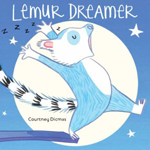 Louis the lemur, who lives on the top floor at 32 Pebbly Lane, is a sleepwalker. During nightly wanderings, he usually just “snoozed” around the other apartments and then “snuffled” back to bed. Then one night, Louis snoozes down a clothesline and snuffles into traffic. What is he dreaming? Where is he going? His concerned neighbors follow him until he runs out of places to sleepwalk. They shout, “WAKE UP, LOUIS!!!” just as Louis, who is still fast asleep, falls off the edge of a cliff. His friends form a chain and pull him safely back up onto the cliff. As Louis tells them about the amazing adventure he was having in his dream, he realizes his sleepwalking is causing a lot of trouble. Not to worry. The next day, the neighbors give Louis the perfect gift to keep him safe no matter where his dreams take him.
Louis the lemur, who lives on the top floor at 32 Pebbly Lane, is a sleepwalker. During nightly wanderings, he usually just “snoozed” around the other apartments and then “snuffled” back to bed. Then one night, Louis snoozes down a clothesline and snuffles into traffic. What is he dreaming? Where is he going? His concerned neighbors follow him until he runs out of places to sleepwalk. They shout, “WAKE UP, LOUIS!!!” just as Louis, who is still fast asleep, falls off the edge of a cliff. His friends form a chain and pull him safely back up onto the cliff. As Louis tells them about the amazing adventure he was having in his dream, he realizes his sleepwalking is causing a lot of trouble. Not to worry. The next day, the neighbors give Louis the perfect gift to keep him safe no matter where his dreams take him.
Old MacDonald Has a Boat. Steve Goetz. Ill. Eda Kaban. 2018. Chronicle.
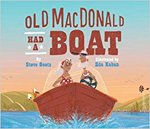 Old MacDonald had a farm, and on that farm he had a truck (which readers learned about in Old MacDonald Had a Truck (2016)). And on that farm he had a wife, who drives the truck into the farmyard with a boat shell and supplies. Old MacDonald, Mrs. Mac, and a crew of farm animals get to work and very soon—with a lot of E-I-E-I-O-ing and buzzing of saws, banging of hammers, shhh-shhing of sandpaper, and rolling on of paint—they have a snazzy boat, the Finnastic. Putting the boat on a trailer and filling the truck with equipment for water play, they all head to the lake for a day of water skiing. “Old MacDonald had a farm / E-I-E-I-O. / And on that farm he had a . . . / BOAT! / E-I-E-I-TOWWWW!” The colorful, detailed illustrations depicting farm and lake activities make this interactive read-aloud—or sing-aloud—book loads of fun.
Old MacDonald had a farm, and on that farm he had a truck (which readers learned about in Old MacDonald Had a Truck (2016)). And on that farm he had a wife, who drives the truck into the farmyard with a boat shell and supplies. Old MacDonald, Mrs. Mac, and a crew of farm animals get to work and very soon—with a lot of E-I-E-I-O-ing and buzzing of saws, banging of hammers, shhh-shhing of sandpaper, and rolling on of paint—they have a snazzy boat, the Finnastic. Putting the boat on a trailer and filling the truck with equipment for water play, they all head to the lake for a day of water skiing. “Old MacDonald had a farm / E-I-E-I-O. / And on that farm he had a . . . / BOAT! / E-I-E-I-TOWWWW!” The colorful, detailed illustrations depicting farm and lake activities make this interactive read-aloud—or sing-aloud—book loads of fun.
The Tiptoeing Tiger. Philippa Leathers. 2018. Candlewick.
 Little Tiger’s big brother says he is too small and clumsy to scare anyone. Out to prove him wrong, Little Tiger begins to tiptoe through the forest as quietly as he can. “Tiptoe, tiptoe, tiptoe . . . ROAR!!!” Little Tiger fails at scaring Boar, who says he hears him coming from a mile away; Elephant, who says he’s too small to scare him; and three monkeys in a tree, who just laugh at him. Discouraged but determined, Little Tiger spies an animal he is certain he can scare, a frog jumping into a pond. He creeps up to the water’s edge. “Tiptoe, tiptoe, tiptoe . . . ROAAARR!!!” and at last succeeds. Leather’s depiction of an ever-so-cute Little Tiger tiptoeing through the forest in her digitally combined pencil-and-watercolor illustrations will have young children mimicking Little Tiger’s movements and roaring at storytime.
Little Tiger’s big brother says he is too small and clumsy to scare anyone. Out to prove him wrong, Little Tiger begins to tiptoe through the forest as quietly as he can. “Tiptoe, tiptoe, tiptoe . . . ROAR!!!” Little Tiger fails at scaring Boar, who says he hears him coming from a mile away; Elephant, who says he’s too small to scare him; and three monkeys in a tree, who just laugh at him. Discouraged but determined, Little Tiger spies an animal he is certain he can scare, a frog jumping into a pond. He creeps up to the water’s edge. “Tiptoe, tiptoe, tiptoe . . . ROAAARR!!!” and at last succeeds. Leather’s depiction of an ever-so-cute Little Tiger tiptoeing through the forest in her digitally combined pencil-and-watercolor illustrations will have young children mimicking Little Tiger’s movements and roaring at storytime.
Ages 9–11
Lucky Enough (Fred Bowen Sports Stories). Fred Bowen. 2018. Peachtree.
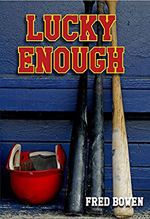 Trey credits his good luck charm, a piece of dark blue sea glass he found while beachcombing with his grandmother, for securing him a coveted position on the under-thirteen baseball travel team, the Ravens. With his lucky charm in his uniform pocket, and his superstitious routine on the field, things are going well. His batting and fielding stats keep getting better—until the day he loses the sea glass. Trey’s desperate search for it fails, and his performance slumps. It takes extra practice sessions with the coach, conversations with the groundskeeper, and a reminder from a family member that, “The harder you work the luckier you get,” to make Trey realize that he is “lucky enough.” As he does in his other books in the Sports Story series, Bowen includes a “The Real Story” section related to the story, which adds an interesting history of superstitions surrounding the game and superstitions and jinxes that famous baseball players have believed in.
Trey credits his good luck charm, a piece of dark blue sea glass he found while beachcombing with his grandmother, for securing him a coveted position on the under-thirteen baseball travel team, the Ravens. With his lucky charm in his uniform pocket, and his superstitious routine on the field, things are going well. His batting and fielding stats keep getting better—until the day he loses the sea glass. Trey’s desperate search for it fails, and his performance slumps. It takes extra practice sessions with the coach, conversations with the groundskeeper, and a reminder from a family member that, “The harder you work the luckier you get,” to make Trey realize that he is “lucky enough.” As he does in his other books in the Sports Story series, Bowen includes a “The Real Story” section related to the story, which adds an interesting history of superstitions surrounding the game and superstitions and jinxes that famous baseball players have believed in.
Uncle Shawn and Bill and the Almost Entirely Unplanned Adventure. A. L. Kennedy. Ill. Gemma Correll. 2018. Kane Miller.
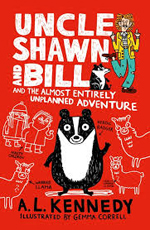 Badger Bill has been kidnapped by nasty sisters Ethel and Maude McGloone, who plan to have him box as Battling Bob Badger in a series of matches with three ferocious dogs: Ripper, Cracker, and Snapper. Bill isn’t the only one in need of rescue. Four llamas—Brian, Carlos, Guinevere, and Ginalolobrigida—get a free trip to McGlorious McGetaway at McGloone Llama Paradise after winning a poetry contest advertised in The Lima Llama Informer. Now, held captive behind an electric fence at the McGloone Farm, the llamas are nearly bald from being overly sheared by Farmer McGloone’s wife, who uses their wool to knit luxury llama wool socks, and they’re worried about becoming other McGloone’s Luxury Products—such as llama pies and llama skin wallets. In the nick of time, Uncle Shawn comes with a rescue plan (well, actually an almost entirely unplanned plan), which involves a lot of dancing and a mole friend. Correll’s clever black-and-white cartoons add to the fun of reading this laugh-out-loud story.
Badger Bill has been kidnapped by nasty sisters Ethel and Maude McGloone, who plan to have him box as Battling Bob Badger in a series of matches with three ferocious dogs: Ripper, Cracker, and Snapper. Bill isn’t the only one in need of rescue. Four llamas—Brian, Carlos, Guinevere, and Ginalolobrigida—get a free trip to McGlorious McGetaway at McGloone Llama Paradise after winning a poetry contest advertised in The Lima Llama Informer. Now, held captive behind an electric fence at the McGloone Farm, the llamas are nearly bald from being overly sheared by Farmer McGloone’s wife, who uses their wool to knit luxury llama wool socks, and they’re worried about becoming other McGloone’s Luxury Products—such as llama pies and llama skin wallets. In the nick of time, Uncle Shawn comes with a rescue plan (well, actually an almost entirely unplanned plan), which involves a lot of dancing and a mole friend. Correll’s clever black-and-white cartoons add to the fun of reading this laugh-out-loud story.
Ages 12–14
The Ambrose Deception. Emily Ecton. Ill. Gilbert Ford. 2018. Disney-Hyperion.
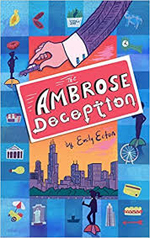 Three Chicago students—Melissa Burris from Morton Middle School, Wilf Samson from Sutherland Academy, and Bondi Johnson at Noyes Central—unexpectedly find themselves invited to compete in the Kaplin/Baron Academic Scholarship contest. To win the $10,000 scholarship, a contestant must solve three cryptic clues to identify Chicago landmarks. They must also sign a contract specifying that they will abide by the contest rules, including no discussion of clues with other competitors or outside elements. Each is provided with a cell phone, a camera, a debit card, and a driver. The three contestants take very different approaches to solving the clues, but as the organizers appear to be taking advantage of the rule about their right to alter the rules, they become increasingly suspicious about the contest. Middle-grade readers will enjoy following along with Melissa, Wilf, and Bondi as they decide to break the rules and work as a team to untangle the real mystery behind the Ambrose deception.
Three Chicago students—Melissa Burris from Morton Middle School, Wilf Samson from Sutherland Academy, and Bondi Johnson at Noyes Central—unexpectedly find themselves invited to compete in the Kaplin/Baron Academic Scholarship contest. To win the $10,000 scholarship, a contestant must solve three cryptic clues to identify Chicago landmarks. They must also sign a contract specifying that they will abide by the contest rules, including no discussion of clues with other competitors or outside elements. Each is provided with a cell phone, a camera, a debit card, and a driver. The three contestants take very different approaches to solving the clues, but as the organizers appear to be taking advantage of the rule about their right to alter the rules, they become increasingly suspicious about the contest. Middle-grade readers will enjoy following along with Melissa, Wilf, and Bondi as they decide to break the rules and work as a team to untangle the real mystery behind the Ambrose deception.
Black Panther, the Young Prince. Roland L. Smith. 2018. Marvel/Disney.
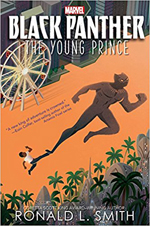 Smith offers fans of the Marvel Universe an origin story of the Black Panther. When the remote, technologically advanced African nation of Wakanda is threatened with invasion, ruling Black Panther, King of Wakanda, sends 12-year-old T’Challa, the young prince and future Black Panther, and his best friend, M’Baku, to Chicago for safety (and to learn about the outside world). With a false identity as an exchange student named T. Charles and a ring and a suit made of the super strong metal Vibranium to be used only in the case of extreme emergency, T’Challa must navigate life as a student at South Side Middle School. He makes some friends but also an enemy, Gemini Jones. As strange things occurring on campus turn sinister, T’Challa is challenged to uncover Gemini’s involvement with ancient dark magic in Chicago and its ties to events in Wakanda. This fast-paced adventure ends with classmate Sheila asking T’Challa, “When’s the next mission?”
Smith offers fans of the Marvel Universe an origin story of the Black Panther. When the remote, technologically advanced African nation of Wakanda is threatened with invasion, ruling Black Panther, King of Wakanda, sends 12-year-old T’Challa, the young prince and future Black Panther, and his best friend, M’Baku, to Chicago for safety (and to learn about the outside world). With a false identity as an exchange student named T. Charles and a ring and a suit made of the super strong metal Vibranium to be used only in the case of extreme emergency, T’Challa must navigate life as a student at South Side Middle School. He makes some friends but also an enemy, Gemini Jones. As strange things occurring on campus turn sinister, T’Challa is challenged to uncover Gemini’s involvement with ancient dark magic in Chicago and its ties to events in Wakanda. This fast-paced adventure ends with classmate Sheila asking T’Challa, “When’s the next mission?”
Ages 15+
Love and Other Train Wrecks. Leah Konen. 2018. Katherine Tegen/HarperCollins.
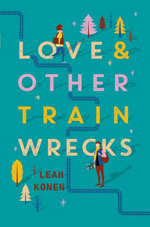 Two strangers meet while traveling on a train to Hudson, New York. High school senior Ammy West from Roanoake, Virginia, is headed to her father’s commitment ceremony (a “wedding non-wedding” because her parents’ divorce hasn’t been finalized). Noah Adler, a freshman at Hunter College, is headed to Hudson with hopes of wooing back his ex-girlfriend with roses and dinner at a swanky restaurant on the anniversary of their first date. Their first impressions of each other are not good, but when the train breaks down during a snowstorm and no one knows when travel will resume, the two teens decide to leave the train together and set out for a bus station a mile away. As they begin their trek through the snow, however, they head in the wrong direction. This is just the first in a series of misadventures that result in the missing of their special occasions and not arriving in Hudson until the next day. Readers will not be surprised by the development of a mutual, if conflicted, romantic attraction—until a train wreck of an unsettling connection between Ammy and Noah is revealed.
Two strangers meet while traveling on a train to Hudson, New York. High school senior Ammy West from Roanoake, Virginia, is headed to her father’s commitment ceremony (a “wedding non-wedding” because her parents’ divorce hasn’t been finalized). Noah Adler, a freshman at Hunter College, is headed to Hudson with hopes of wooing back his ex-girlfriend with roses and dinner at a swanky restaurant on the anniversary of their first date. Their first impressions of each other are not good, but when the train breaks down during a snowstorm and no one knows when travel will resume, the two teens decide to leave the train together and set out for a bus station a mile away. As they begin their trek through the snow, however, they head in the wrong direction. This is just the first in a series of misadventures that result in the missing of their special occasions and not arriving in Hudson until the next day. Readers will not be surprised by the development of a mutual, if conflicted, romantic attraction—until a train wreck of an unsettling connection between Ammy and Noah is revealed.
Carolyn Angus is former Director of the George G. Stone Center for Children's Books, Claremont Graduate University, in Claremont, California.
These reviews are submitted by members of the International Literacy Association's Children's Literature and Reading Special Interest Group (CL/R SIG) and are published weekly on Literacy Daily.